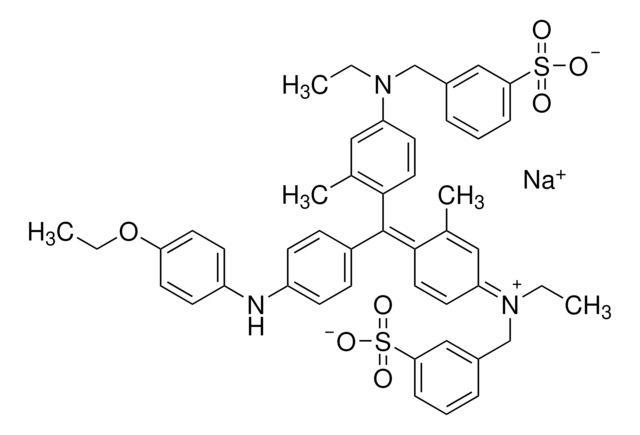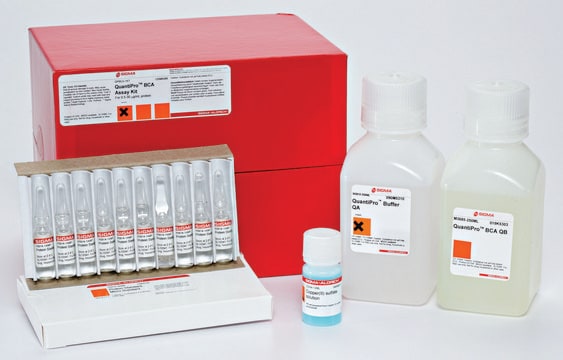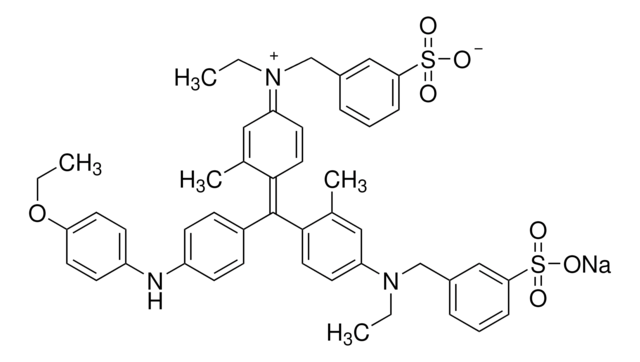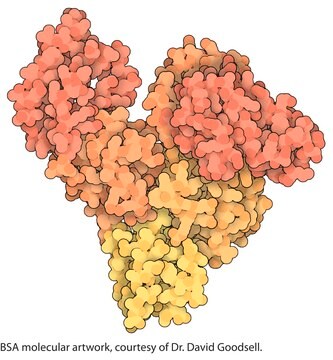Recommended Products
General description
Application
Features and Benefits
- The reagent is ready to use. No mixing or dilution required.
- Color development is rapid. Only a five minute incubation and then the sample is read a 595 nm.
- Reducing sugars and reducing substances along with thiols do not interfere with this reagent.
- Reagent is suitable for micro (1-10 μg/ml) and standard (50-1400 μg/ml) assays.
- Can be used in microwell plate assays.
- Inexpensive assay.
Legal Information
Application
also commonly purchased with this product
related product
Signal Word
Warning
Hazard Statements
Precautionary Statements
Hazard Classifications
Eye Irrit. 2 - Met. Corr. 1 - Skin Irrit. 2 - STOT SE 2
Storage Class Code
8B - Non-combustible, corrosive hazardous materials
WGK
WGK 1
Flash Point(F)
Not applicable
Flash Point(C)
Not applicable
Certificates of Analysis (COA)
Search for Certificates of Analysis (COA) by entering the products Lot/Batch Number. Lot and Batch Numbers can be found on a product’s label following the words ‘Lot’ or ‘Batch’.
Already Own This Product?
Documents related to the products that you have purchased in the past have been gathered in the Document Library for your convenience.
Difficulty Finding Your Product Or Lot/Batch Number?
How to Find the Product Number
Product numbers are combined with Pack Sizes/Quantity when displayed on the website (example: T1503-25G). Please make sure you enter ONLY the product number in the Product Number field (example: T1503).
Example:
Additional examples:
705578-5MG-PW
PL860-CGA/SHF-1EA
MMYOMAG-74K-13
1000309185
enter as 1.000309185)
Having trouble? Feel free to contact Technical Service for assistance.
How to Find a Lot/Batch Number for COA
Lot and Batch Numbers can be found on a product's label following the words 'Lot' or 'Batch'.
Aldrich Products
For a lot number such as TO09019TO, enter it as 09019TO (without the first two letters 'TO').
For a lot number with a filling-code such as 05427ES-021, enter it as 05427ES (without the filling-code '-021').
For a lot number with a filling-code such as STBB0728K9, enter it as STBB0728 without the filling-code 'K9'.
Not Finding What You Are Looking For?
In some cases, a COA may not be available online. If your search was unable to find the COA you can request one.
Which document(s) contains shelf-life or expiration date information for a given product?
If available for a given product, the recommended re-test date or the expiration date can be found on the Certificate of Analysis.
Will the buffer or solution my protein is in interfere with Product B6916, Bradford Reagent?
A compatibility chart is listed in the bulletin. If your substance is not listed, then we recommend testing this by diluting the standard protein samples in the same buffer as the unknown samples.
What is the useful concentration range that can be measured by Product B6916, Bradford Reagent?
The Bradford Reagent requires no dilution and is suitable for micro, multiwell plate, and standard (cuvet) assays. The linear concentration range is 0.1-1.4 mg/mL of protein, using BSA (bovine serum albumin) as the standard protein.
When using Product B6916, Bradford Reagent, how soon after my color development do I need to read my assay?
he protein-dye complex is stable up to 60 minutes. The absorbency of the samples must be recorded before the 60 minute time limit and within 10 minutes of each other.
When using Product B6916, Bradford Reagent, what can I do if I have a very dilute sample in a large volume?
The micro assay using this same reagent may be an option for you. The micro assay is used when a large volume (at least 1 mL) of a dilute sample is available for testing. The linear concentration range of this assay is lower than the standard or multiwell plate assays, (1-10 μg of total protein in 1 mL).
Is the BSA standard supplied with Product B6916, Bradford Reagent?
No, we do not supply the BSA standard with this reagent. We recommend using one of the following products: Protein Standard (BSA) Solution, (2 mg/mL), Product No. P0834 or Protein Standard (BSA) Solution, (1 mg/mL), Product No. P0914, if lower concentrations of protein are to be measured.
How do I get lot-specific information or a Certificate of Analysis?
The lot specific COA document can be found by entering the lot number above under the "Documents" section.
How do I find price and availability?
There are several ways to find pricing and availability for our products. Once you log onto our website, you will find the price and availability displayed on the product detail page. You can contact any of our Customer Sales and Service offices to receive a quote. USA customers: 1-800-325-3010 or view local office numbers.
What is the Department of Transportation shipping information for this product?
Transportation information can be found in Section 14 of the product's (M)SDS.To access the shipping information for this material, use the link on the product detail page for the product.
My question is not addressed here, how can I contact Technical Service for assistance?
Ask a Scientist here.
Articles
The field of proteomics is continually looking for new ways to investigate protein dynamics within complex biological samples. Recently, many researchers have begun to use RNA interference (RNAi) as a method of manipulating protein levels within their samples, but the ability to accurately determine these protein amounts remains a challenge. Fortunately, over the past decade, the field of proteomics has witnessed significant advances in the area of mass spectrometry. These advances, both in instrumentation and methodology, are providing researchers with sensitive assays for both identification and quantification of proteins within complex samples. This discussion will highlight some of these methodologies, namely the use of Multiple Reaction Monitoring (MRM) and Protein-AQUA.
Related Content
Protein quantification methods, reagents, and immunoassay technology for accurately measuring the protein concentrations in a variety of samples.
Our team of scientists has experience in all areas of research including Life Science, Material Science, Chemical Synthesis, Chromatography, Analytical and many others.
Contact Technical Service






